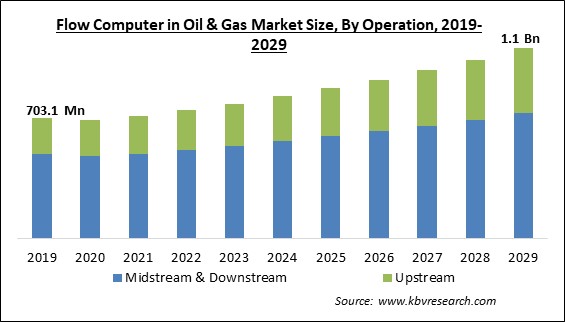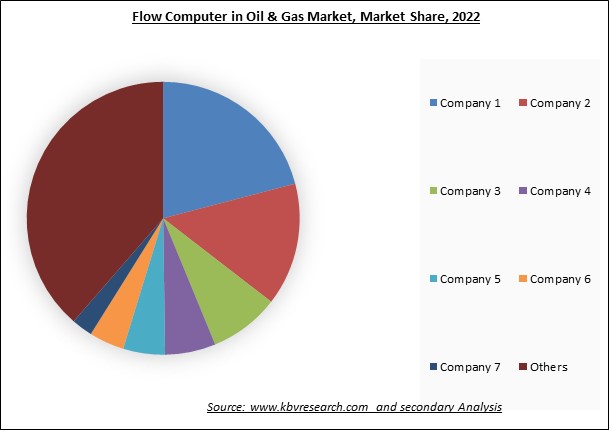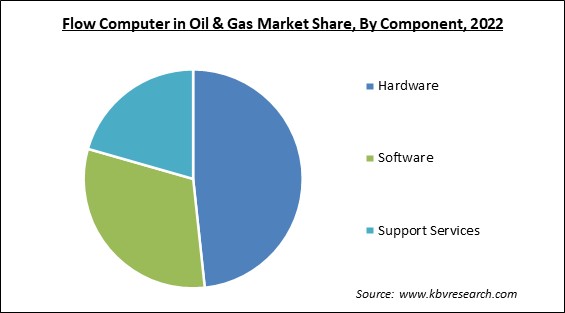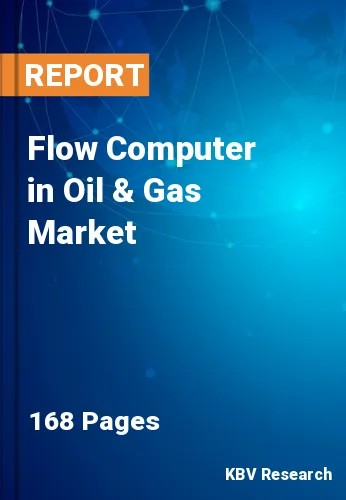The Global Flow Computer in Oil & Gas Market size is expected to reach $1.1 billion by 2029, rising at a market growth of 5.9% CAGR during the forecast period.
In the oil and gas business, flow computer equipment is used to measure the supply of liquid and gas. Using data from temperature transmitters, flow meters, and pressure transmitters, flow computers determine the exact flow of liquid or gas going through the pipelines. It accurately calculates the flow rate and logs data, important events, and alarms with the help of interfaced devices. The data is subsequently sent to other computers or workstations for management and accounting purposes.

The need for exact measurement arises from the high oil and gas resources cost. This means that the oil and gas sectors require flow computers at numerous sites for precise flow computing as well as trustworthy monitoring, flow measurement, and control. There are a variety of different controls used in the oil & gas sector that are required to keep a close eye on fluid mass dynamics.
As a result, many types of supporting equipment are needed to monitor the flowing mass, such as pressure gauges, temperature probes, gas composition sensors, and density measurement tools. Sampling systems and meter provers are also required to validate the data being gathered from the various sensors in the system. In addition, when the pipe is turbulent, the employment of a flow conditioning unit can be extremely helpful in verifying the velocity profile of the flow dynamics.
Moreover, each of these sensors must be tailored to the environment in which it operates, but a flow computer can be configured to aggregate all of these data sources concurrently, according to the many priorities that are unique to the stage of the process wherein they operate. These requirements can range from those resulting from safety concerns and environmental circumstances to volume logging or composition data, all dependent on the fluid type being communicated
The COVID-19 pandemic has profoundly impacted both market expansion and the state of the economy as a whole. Several businesses have temporarily stopped operating or substantially reduced their operations due to the outbreak, disrupting supply chains and creating economic instability. COVID-19 has impacted several aspects of the flow computer in oil & gas market. For instance, the decline in consumer spending has resulted in a fall in the market's demand for goods and services. Also, many oil and gas companies had to temporarily reduce or stop their operations, which had a detrimental effect on the market's growth and profits. thereby aiding the flow computer in the oil & gas market to recover from the initial losses and grow in the post-pandemic period.
The oil and gas sector are rapidly going digital with better operations, fostering the emergence of the digital economy. New developments in this sector include digital transformation and automation. For example, digital transformation or automation makes deploying minimal personnel in remote onshore and offshore exploration sites possible. Due to the limited oil or fuel supply for the expanding number of vehicles and the resulting demand for operational digital oilfield solutions, the oil industry is forced to adopt new and enhanced technology. Thus, the technological advancement in the oil & gas industry is expected to increase the implementation of flow computers in the sector, thereby propelling market growth.
The industry’s penetration will be fueled by the ongoing use of unconventional oil and gas assets, including shale and tight gas, and cutting-edge technical solutions for more effective oil and gas production rates. Increased investment to enhance crude oil output and increasing need for light distillates will positively impact the industry landscape. The segment statistics will be complemented by the high dependability of the power generation resources and the retirement of the coal-fired power substations. The increased oil & gas industry is expected to surge the adoption and utilization of flow computer due to its provided benefits during the operation and thus drive the market’s growth.

The leading players in the market are competing with diverse innovative offerings to remain competitive in the market. The illustration shows the percentage of revenue shared by some of the leading companies in the market. The leading players of the market are adopting various strategies in order to cater demand coming from the different industries. The key developmental strategies in the market are Acquisitions, and Partnerships & Collaborations.
Flow computers are renowned for offering precise and trustworthy flow measurements in the oil and gas sector. They need specialized parts and manufacturing procedures to produce flow measurements that are highly accurate and trustworthy. Modern components offer further functionality and features that give them an edge over conventional flow measurements devices, such as the simultaneous measurement of several fluid parameters and diagnostic and calibration features. Hence, operators wanting to reduce their cost of ownership are constrained by high product and maintenance costs, hindering the market growth.
On the basis of operation, the flow computer in oil & gas market is divided into upstream and midstream & downstream. The midstream & downstream segment witnessed the largest revenue share in the flow computer in oil & gas market in 2022. This is because pipelines and tankers in the midstream transport crude oil and natural gas. Since these pipelines transport expensive and critical goods, they need to be constantly watched. The flow computers handle valve control, batching, product interface, metering, meter proving, ticketing, and metering. Positive displacement, ultrasonic, Coriolis, and turbine flow meters connected to flow computers are mostly employed in midstream applications.

Based on component, the flow computer in oil & gas market is segmented into hardware, software and support services. The support services segment acquired a promising growth rate in the flow computer in oil & gas market in 2022. This is owing to the fact that these support services offer the whole spectrum of services necessary to maximize the return on investment. These services put the ideas into practice to support the business from plant concept to startup. Once the business is up and operating, they provide a wide range of maintenance, dependability, and performance services as required.
| Report Attribute | Details |
|---|---|
| Market size value in 2022 | USD 750 Million |
| Market size forecast in 2029 | USD 1.1 Billion |
| Base Year | 2022 |
| Historical Period | 2019 to 2021 |
| Forecast Period | 2023 to 2029 |
| Revenue Growth Rate | CAGR of 5.9% from 2023 to 2029 |
| Number of Pages | 168 |
| Number of Table | 250 |
| Report coverage | Market Trends, Revenue Estimation and Forecast, Segmentation Analysis, Regional and Country Breakdown, Market Share Analysis, Companies Strategic Developments, Company Profiling |
| Segments covered | Component, Operation, Region |
| Country scope | US, Canada, Mexico, Germany, UK, France, Russia, Spain, Italy, China, Japan, India, South Korea, Singapore, Malaysia, Brazil, Argentina, UAE, Saudi Arabia, South Africa, Nigeria |
| Growth Drivers |
|
| Restraints |
|
Region-wise, the flow computer in oil & gas market is analyzed across North America, Europe, Asia Pacific, and LAMEA. The Asia Pacific region garnered a considerable growth rate in the flow computer in oil & gas market in 2022. This is due to the region's quickest growth rates for emerging technologies compared to other regions. Companies are relocating to offer automation designed for the oil and gas sector. Oil and gas businesses in the region are installing flow-metering instruments that enable computational power.
Free Valuable Insights: Global Flow Computer in Oil & Gas Market size to reach USD 1.1 Billion by 2029
The market research report covers the analysis of key stake holders of the market. Key companies profiled in the report include Emerson Electric Co., Honeywell International, Inc., ABB Ltd., Thermo Fisher Scientific, Inc., Schneider Electric SE, TechnipFMC plc, Sick AG, Badger Meter, Inc., Hoffer Flow Controls, Inc., and Spirax Sarco Limited.
By Operation
By Component
By Geography
The Market size is projected to reach USD 1.1 billion by 2029.
Oil and gas sector's technological advancement are driving the Market in coming years, however, The high cost associated with flow compute restraints the growth of the Market.
Emerson Electric Co., Honeywell International, Inc., ABB Ltd., Thermo Fisher Scientific, Inc., Schneider Electric SE, TechnipFMC plc, Sick AG, Badger Meter, Inc., Hoffer Flow Controls, Inc., and Spirax Sarco Limited.
The Hardware segment is leading the Market by Component in 2022 thereby, achieving a market value of $522.8 million by 2029.
The North America market dominated the Global Flow Computer in Oil & Gas Market by Region in 2022 thereby, achieving a market value of $373.7 million by 2029.
Our team of dedicated experts can provide you with attractive expansion opportunities for your business.

